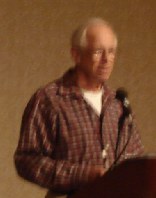|
|
|
|||
|
|
|||
|
|
|||
| . . Homepage. . . . What We've Been Up To. . . . About Me & Al. . . . Teddington. . . . Pictures. . . . Puzzles. . . . Puzzles Too. . . . Music. . . . Misc. . . . My Films. . . . Credits etc. . |
|
||||
|
|
||||
|
As featured in Web User magazine. Contact me here. Pictures from my collection here. Puzzle News for 2012 onwards is here. December 30th, 2011 - I have just heard the shocking news that Tobar, the Suffolk, UK-based company behind toy shop Hawkins Bazaar has gone into administration. Hawkin was set up in 1973 and sells unusual toys, gifts, games, gadgets and curiosities. It describes itself as selling "things you thought had gone forever, things you never even knew existed". I’ve been one of their customers for more years than I can remember, apparently not in large enough quantities. Losing them, if they stop trading, is a sad indictment against a generation which values techno-gadgets more than some of the great toys of the past.
This page is getting rather long, so I will soon start a Puzzle News 2012 page. I’d been wondering about thinning out my collection, but found it a very difficult decision. I have two very fine Akio Kamei items Star and Twin Ball, which may be first to go. They’re beautiful, but not my type anymore. December 15th, 2011 - I recently wrote three short articles about puzzles which I have added to my collection in 2011. As the article was subsequently edited, I am pleased to include the full descriptions and photographs here. I selected three puzzles, all of which together cost me less than £5. Puzzling isn’t all about “the one who dies with the best toys wins”! Busy Beetles is a tessellation puzzle, Plywood Puzzles is a set of six sliding block puzzles and finally a set of nine wooden cube dissections.
November 2011 - I am suddenly finding that my Digigrams puzzle, and designed by me in the late 1990s, presented by Patrick Major at the 2001 International Puzzle Party in Tokyo, is being illegally produced by companies in the Far East. Anyone who can help me do anything to combat this puzzle piracy, please contact me. It is bad enough that it is being produced without my permission, and without acknowledging me as designer, but it is even being sold under various other names, such as “Count me in” and “Numeracy Box”. October 2011 - the 100th monthly London Puzzle Party took place at Camden Lock. September 2011 (I think) I get more holiday than Alice, so I took a week off to build myself some puzzle shelves. I use large plastic boxes, like giant Tupperware, to store puzzles, but, although they stack well, it’s no fun moving 5 heavy boxes to get at the bottom one. I designed these shelves so that the boxes slide in and out. They took me 4 half days to make, after detailing them on paper. Total cost, about £150. Subsequent reorganising of my collection had brought to light many items that I’d totally forgotten about, as well as several I’ve been looking for for ages. It’s got to the point where I’ve had to start storing small items, (typically anythging small than a Rubik’s cube) in the smaller containers, leaving progressively larger containers for progressively larger items. It’s not the most metagrobologically ideal system, but it is tidy and compact. I’d like to photograph everything, but it is probably too late to start... I’m wondering about making 10-15 minute YouTube films of the contents of each container. (After all my Dismantling a 12-piece Interlocking Burr Puzzle has now had nearly 30,000 viewings in four and a half years, and it’s hardly a masterpiece). Another advantage of storing them all based on size is that every container has a varied selection rather than having all of one type together. August 2011 International Puzzle Party in Berlin. January 9th, 2011 Severe arm-strain from using a mouse has prevented me from writing much here, and has even affected my puzzling activities. Here are a few pictures of recent acquisitions. This page is getting rather long, so I will soon start a Puzzle News 2011 page.
November 3rd, 2010 At long last I have added the story of our 2007 Berlin Puzzle Party, and lots of puzzling pictures. August 22nd, 2010
I’d also like to mention the web site of Kohfuh Satoh, who we met in Japan in July 2010. He has some really nice puzzles of his own design. How about some more, Kohfuh? August 17th, 2010
“The wooden cube ends are made from Western Australian Jarrah. Brian spent a lot of time laminating them with Jarrah veneer to give the finished puzzle a smooth modern look, but this does hide the amount of effort that went into harmonising the different materials into a single piece. Two of the burr pieces have centre mazes which are waterjet cut from 25mm aluminium laminated to wooden ends, the third has a very strong polycarbonate rod joining the wooden ends. Size of each piece: 150mm x 50mm x 50mm.” August 2nd, 2010 Here are some interesting architectural impossibilities. They remind me of the Winchester House which we visted during the San Francisco International Puzzle Party in 2009. July 26th, 2010 Here is a picture of my birthday present from Alice. It’s a Heavy-headed Burr, designed by my friend and IPP30 Mt Fuji Tour organiser, Junichi Yananose. It is one of only three made by Hiroshi Iwahara of the Karakuri Design Group for the 2008 Design Competition. It is made from oak, rosewood and zelkova. (picture courtesy John Rausch Puzzle World.) and a link to the rest of the puzzles I got in Japan at this year’s International Puzzle Party. May 15th, 2010 Here is every definition of ‘puzzle’ that you could ever want, along with translations, links and references, and lots more. A good way to say goodbye to an hour or more... May 9th, 2010 One to listen out for on BBC Radio 4, Thursday 13th May, 11:30am to 12:04pm Chris Ledgard introduces you to Go, the ancient Chinese strategy game that is deeply woven into east Asian culture but refuses to become popular in the West. An apparently simple territorial battle between black and white counters on a 19x19 grid, Go really does fulfil the gaming cliche of taking an hour to learn and a lifetime to master. But there’s even more to it than that. Where its perennial competitor chess attracts analytical, even mathematical minds, Go players say its beautiful, fluid patterns are more like a language. One devotee dismisses the infinite possibilities of chess as claustrophobic. Ledgard’s subsequent detour through various dusty, Go-themed oriental artefacts is a little dry compared to the clank of pieces on a board, but it illustrates the game’s immortal mystique May 7th, 2010, 12:20 It looks as if my forecast last night was right. The puzzles below are available from Village Games, at Camden Lock. Click. May 6th, 2010, 22:00 Election day in the UK. I think the Conservatives will scrape in, but here are three sliding tile puzzles to help you decide!
February 21st, 2010 I have added a page including photographs (see one below) of my creations with MagFormers. They are flat polygons with neodymium magnets loose in the frames. They are wonderful for rapidly constructing polyhedra.
December 2009 November 2009 I took these pictures a few years ago while assembling The Lost Day puzzle, a 24-piece gigantic burr. Now that we have faster net access, you can enjoy the process here. By the way, it took me a weekend, the t-shirt change is a clue!. Scenes from the International Puzzle Party in San Francisco. My friend Patrick Major presented one of my designs in the Puzzle Exchange. May 2009
Order online here from Spreadshirt.net
April 2009 I have a temporary San Francisco page. April 13th 2009 Alice and I have both just finished reading “Slumdog Millionaire”. It is a wonderful, totally uplifting book. Towards the end I found a hidden code in it, which I cracked. I can’t find any reference to this anywhere on the internet. Surely I am not the first? Knowing the secret of the code adds a little extra poignancy to the tale. March 2009 I’ve put photographs of puzzles for sale here. Sadly they must be collected from me unless you want to buy quite a few. I don’t have the time to pack and post small quantities. They are almost all 5 UK pounds each. Bedlam Cubes and Watson’s Tribulations are £10. Discount for bulk. September 25th 2008 I had known Kevin Holmes for over 20 years, and was saddened to hear of his passing. I first met him in the 1980s on his stall selling puzzles in Covent Garden, London. Over the years I must have bought every puzzle he ever stocked, but his two major contributions to my life were selling me a copy of Hoffman's Puzzles, and convincing me to apply to attend the London puzzle party in 1999. He is responsible for me making so many good friends over the years. I clearly remember him introducing me to Nob Yoshigahara at that puzzle party, as well as a visit to his workshop a couple of years later. We often discussed the idea of a cube puzzle dedicated to Holmes and Watson, Sir Arthur Conan Doyle's creations. Sadly that project never grew to fruition. Probably his greatest contribution was as an ambassador for puzzles, as he was always ready to educate and entertain his customers on his stall in Covent Garden. He didn't actually have a "Please Touch" sign, but I never ever saw him discourage inquisitive fingers, belonging to prospective customers of what ever age. Happy puzzling, Kevin. February 9th 2008 Reports are just coming in of a major fire in Camden, NW London, at the bottom of the lane that leads up to Village Games. Investigators have not linked the blaze to disgruntled puzzle wives or unsuccessful would-be puzzle solvers. February 2nd, 2008 My thanks to Robert Reid for pointing out this article on punding, tweaking and stimming. There’s an interesting collection of puzzles here, only one of which, Pack Four, I have previously seen. January 12th 2008 It is with very great sadness that I must report the death of my good puzzle friend Fred Armitage. He unexpectedly died quietly in his sleep at his home last week, following a very short illness. I had known Fred for over 20 years, and for at least the last 12 of those we used to meet every Friday at a local pub to discuss and solve puzzles. His passing will leave a very great hole in my life. Many of you will have met him in Antwerp at the 2002 puzzle party, when he was my exchange assistant. He was also a regular attendee at the monthly puzzle party in Camden in London. November 2007
Send me one for Christmas, Santa! I’ve also heard that Meffert's Puzzles & Games will soon be selling 6x6x6 or 7x7x7 Rubik’s cubes. Just what we all need... October 2007
September 2007
July 2007 It’s set to be a busy puzzling month, with the 50th Camden Puzzle Party on July 4th in London, and my 50th birthday later in the month.
However, look closely and you will notice some subtle differences. It took me a while to fully appreciate the way this set differs from the usual set. The change in size for the small square piece from ((root 2)/2) to (1/3) is quite wonderful. Click here for a template (a PDF file) to cut out and try. I hope to add more on this set of pieces. Martin Gardner looked at all the convex shapes that could be made from the standard set. I am trying likewise with this set. June 2007 My long-time correspondent Odette De Meulemeester, pentomino teacher at Katholiek Secundair Onderwijs - Ronse, Belgium sent me this rendering of my initials using MacMahon tilings. Thanks Odette. Read more here and here.
I thought you would be interested in hearing about my experiences with the 12-piece Altekruse puzzle at the pub on Friday evening.
However, there was one time on Friday when I assembled it, and I think I could only disassemble it in one plane. Perhaps I was deluded by the fine beer! Click on the above picture for more details, from John Rausch’s Puzzle World. I have always been reluctant to take some of my better puzzles into a smoky pub, but as smoking will be banned here in three weeks, things will change. This means I may attempt to dismantle the 36 piece version, sold by a Pentangle as "The 13th Labour of Hercules". May 2007
My thanks to correspondent Peter Wiltshire in Hamilton, Ontario, for adding this one, below.
March 2007 I’ve updated a lot in the Top Tens section, especially Coffee Table Puzzles, but there is still more work to be done. I’ve also added pictures of Puzzling People at play or work.
I don't know how long it took me to get to the stage shown in this picture, which was only achieved using the diagrams on the excellent Puzzles will be Played website, but I was quite exhausted at the end of the afternoon, and I still have seven pieces to put somewhere! The hardest bit was actually putting together the first four or five pieces, as at that time the puzzle had no stability, and very little interlocked. I still wonder whether I wasn't sent enough notches?!
I’d wrongly assumed that people with this sort of thing in their email signatures had too much time on their hands. I was wrong, find out why here. They are called FIGLETS, by the way, after Frank, Ian & Glenn!
February 27th 2007 While searching for something totally different, I came across The Logic Puzzle Museum, in Wisconsin, USA, which describes itself as “Hands-on mechanical & brain puzzles for thinking fun, exhibit, & make a puzzle to keep! This is also the same location as the Spinning Top, Yo-Yo and Gyroscope Museum. Admission applies to all ages and everyone present. The museum is not appropriate for young children or babies, but if they attend, full admission does apply.” February 22nd 2007 Last month I was watching on television one of the Royal Institution Christmas Lectures for Children. One part of it featured a two-player game where the winner was the first player to complete a circle using sectors of a circle from a selection of nine different sectors . Each sector consists of from one to nine fifteenths of a circle, (multiples of 24 deghees). The first player selects one of the nine sectors and places it on the table in front of him. Player two selects a sector and places it likewise in front of him. Player one then plays again, adjacent to his first piece forming a much larger sector of the circle. Player two plays. Player one then can either add a third sector, as long as his total number of sectors doesn’t pass 15, or replace an existing sector with one as yet unplayed. Play continues alternately, until one player creates a complete circle.
Play quickly becomes frustrating, as each player has to ensure that after removing one piece and adding another, the other player can't then complete the circle. While this game is analogous to Noughts & Crosses (also known as Tic-Tac-Toe), there is a difference, as N&C continues for up to nine plays, until the familiar grid is complete. With this game, no more than three pieces are played by either player at any time, because of the option to exchange a piece. When a player decides to do so, he must not only plan his play, but also avoid making a mistake advantageous to his opponent. I have now found out that this is called Sum to Fifteen, developed by Herbert Simon. (See Chapter 16: Jam, Hot and Other Games in Martin Gardner's Mathematical Carnival, based on his Scientific American column of February 1967.) The game can also be played using cards numbered 1-9. February 13th 2007 I’ve added a page of mathematical photographs. Anything vaguely mathematical that caught my eye... Architecture, pavement tilings, window patterns, nature, chaos, in no particular order. This one is my recreation of paving tiles outside Brussels Eurostar station. It was too wet to use the camera.
February 12th 2007
We’re just back from a weekend in Brussels. I had fun taking this apart! February 3rd 2007 I am sure all puzzle collectors have heard comments from non-puzzlers, while trying to work on a puzzle, such as "Oh, I've got some scissors you can borrow", or "I've got a hammer if you need it", or "Do you want to borrow my hacksaw?" A builder friend of mine in the local pub came up with an excellent new alternative, while watching me assemble an intricate burr. He said, "I only check that it looks OK from the front, and that it stays together long enough for the cheque to clear!" On another subject, I've been meaning to mention this here for quite a while. I'd be very interested to hear from anyone reading this, about their strategy for dealing with new puzzles. When you get one, do you get someone else to dismantle it for you, or perhaps mix up all the pieces, or rearrange it, as required? Or do you do it yourself? Or do you carefully take a couple of pieces out, replace them, then take out a few more pieces, before carefully replacing them, and continuing until you have dismantled the whole puzzle, before reassembling it? Or do you make extensive notes, and diagrams, or keep other records? (Or do you not realise that they are for taking apart!) Personally, if it's a burr or an interlocking puzzle I use a combination of the above. I carefully remove pieces drawing diagrams and keeping notes, before finally being able to dismantle a whole puzzle, and reassemble it. I am sure some puzzlers would frown on this system, but at least it means that I will never have a drawer full of pieces that I can never get back together again! I welcome your comments. Contact me here. January 2007 I've decided that I need to severely restrict my puzzle buying, on grounds of lack of space! I’ve added new articles on Prague Puzzle Shops, and here, and a humourous article about Puzzle Bags. December 25th 2006 Alice bought me a Quantum Entanglement, designed by renowned Singaporean puzzle inventor Goh Pit Khiam, for Christmas. The trouble is, though, as it is a level 80 (80 moves to free the first piece), 6-piece boxed burr, I haven’t been able to unpack it yet! December 18th 2006 I’m just back from a carefully-planned lightning puzzle raid on the Czech city of Prague. View the spoils here. The monthly London Puzzle Party took place as usual on the First Wednesday of the month. November 23rd 2006 Just lately I've been revisiting Tantrix tiles. It seems to me that each year we see another wonderful game being sold extensively, which then disappears. However Tantrix has been around for many years now, and quite justifiably so. As well as being well-thought-out, I think the success of this game is due to the high quality of manufacture. The 56 hexagonal tiles are a delight to hold and handle. The UK site is here.
November 18th 2006 It's not really a puzzle-related story, but yesterday was the 2006 Netherlands Domino Day! It was shown on British television this afternoon, and I would not have believed that I would sit and watch over 4 million dominoes toppled in the course of one hour. However it was a thoroughly riveting programme in which the designer-builders tried to beat the previous record of 4,025,000 dominoes. At one time, I would imagine that domino toppling consisted of just a long line of dominoes, however now the dominoes are arranged in truly fantastic patterns, cascading in amazing fashion, this year celebrating the history of popular music. Most of the dominoes are not the standard black ones with which we are familiar, they are coloured on the top edge, and often have a different colour on the back so that after they topple a picture can be revealed. This year pictures included James Dean, one Michael Jackson, a Cadillac, and record players. To make it even more exciting, gaps were left which the builders had to fill once the topple had started, so they were doing it against the clock. Nail-biting stuff! 4,400,000 dominoes had been laid out in a large warehouse or concert hall, and the world record was broken when 4,079,000 dominoes fell. That means over 300,000 dominoes failed to to fall! I look forward to Domino Day 2007! November 14th 2006 If you are looking for a Christmas present for a puzzler, I think that Adrian Fisher’s new maze book should be a serious option to consider. November 16th 2006 I’m wondering about starting a Bad Origami page, for photographs of some of my creations which don’t quite look like they should. Am I the only one who carefully folds thirty-plus modules, carefully interlocks them all, then hides the result with embarrassment? November 6th 2006 My main puzzle achievement of last week while on holiday was solving a six piece Burr. I will probably make it my next puzzle of the month. I can't remember where I got it. Basically it's a fairly standard three-piece burr but each of the three pieces has an extra piece that slides inside it. The basic three-piece Burr is a level 2- 5, (i.e., it takes two moves to remove the first piece, followed by five moves to remove the next piece) but the three inserts make it much harder. I was delighted to solve it, it's only about an inch and a half in each dimension, and I've no idea who made it, from very thin and laser cut plywood I'd guess. Unfortunately, being on holiday last week I missed the November London puzzle party in Camden. October 21st 2006 Wausau ‘82, a 13-piece burr designed by Bill Cutler - When I haven't yet checked which pieces I have incorrectly fitted, but if anyone is interested in details of this please let me know. October 20th 2006 This site, translated a bit doubtfully from Japanese, is full of all sorts of interesting recreational mathematics topics. Sometimes hard going, sometimes incomprehensible, it’s worth the effort to spend a few minutes digging about. Thanks to Masaka Iwai for telling me about it. October 15th 2006 For some time I have been meaning to make a special mention of Rob's Puzzle Page. The section of his site which links to suppliers around the world is so good that I have almost decided not to attempt to try and emulate this part of his creation. August 10th, 2006 The final part of our summer holiday this year after 12 The party started with the Founder's Reception on the Thursday evening, a wonderful boat cruise in Boston harbour. Friday morning started early with the traditional puzzle exchange at which all attendees exchange a puzzle with everybody else. This year I was the assistant to our host Chris Morgan. Meanwhile Alice visited Sturbridge, a re-creation of an 18th century working village. In the evening we enjoyed a sumptuous banquet. Saturday I was fortunate enough to be first out of the hat, and I was able to buy a three piece co-ordinate motion assembly puzzle from Stewart, who I had previously met in Chicago three years ago. I asked him if the puzzle had a name, and he referred to his notes. He told me it it just said "three piece co-ordinate motion, not an interesting design". This greatly amused me and also any body else who saw the puzzle - it might not be interesting to Stewart but to the rest of us it was a small masterpiece. The Party finished with a visit to a Maize Maze. May 2006 As part of the overall website redesign, this is a new page which I hope to maintain regularly. It will feature a brief summary of the Camden Lock Puzzle Nights, an overview of Friday nights with fellow puzzler and real ale-lover Fred Armitage, a look at what puzzles are currently keeping me busy, a brief mention of any new puzzles on the market, and anything else which I think may be of interest. So to start that promise, a brief summary of the May 2006 Camden Puzzle Night. Tim Rowett, A couple of weeks ago I had an unexpected email from a girl called Pallavi who is a shoe designer. Her (initially bizarre) request was for help in designing a combined shoe and puzzle! She brought along her portfolio of shoe designs which included shoe mazes, shoe sliding block puzzles and a prototype cube assembly shoe. The venue for the Camden Lock Puzzle night, the Lockside Lounge, was much quieter than usual as many of the non-puzzlers were able to sit outside due to the better weather. Older Puzzle News is here and also here for very old news. It probably mentions the invention of the tangram... |
|
|
| [Homepage] [What We've Been Up To] [About Me & Al] [Teddington] [Pictures] [Puzzles] [Puzzle News] [My Designs] [Collection on Flickr] [London Puzzle Party] [POTM] [Prague Puzzles] [Prague Puzzle Shops] [Misc Puzzle Stuff] [Puzzle Suppliers] [Mailbag] [Puzzle Bags] [Puzzling People] [Puzzles Too] [Music] [Misc] [My Films] [Credits etc] |
 |
|
|
|
 December 29th, 2011 - I’ll mention some puzzles which were kindly added to my collection by friends and relatives at Christmas. Firstly “Say Cheese”, a rolling block maze which consists of forty challenges each requiring the puzzler to place blocks on a grid then roll them to achieve a position where each block is upside down from the original position. Puzzles are designed by Wei-Hwa Huang.
December 29th, 2011 - I’ll mention some puzzles which were kindly added to my collection by friends and relatives at Christmas. Firstly “Say Cheese”, a rolling block maze which consists of forty challenges each requiring the puzzler to place blocks on a grid then roll them to achieve a position where each block is upside down from the original position. Puzzles are designed by Wei-Hwa Huang. Another puzzle I received, also a game, is "Knot So Fast", requiring the puzzler to arrange a cord and sometimes a ring so that they match a well-known knot as pictured on one of the 40 challenge cards. At this point I’ll also give a mention to Gavin and his team at
Another puzzle I received, also a game, is "Knot So Fast", requiring the puzzler to arrange a cord and sometimes a ring so that they match a well-known knot as pictured on one of the 40 challenge cards. At this point I’ll also give a mention to Gavin and his team at  Finally I now have “Tilt”, which is a sliding block puzzle, however it is different from the standard design of such puzzles, in that you have to tilt the board to slide all loose blocks in the direction of the tilt. The object of the puzzle is to get one or two green discs to fall down the central hole, without anything else following them down. A wonderful and imaginative design by Vesa Timonen.
Finally I now have “Tilt”, which is a sliding block puzzle, however it is different from the standard design of such puzzles, in that you have to tilt the board to slide all loose blocks in the direction of the tilt. The object of the puzzle is to get one or two green discs to fall down the central hole, without anything else following them down. A wonderful and imaginative design by Vesa Timonen.
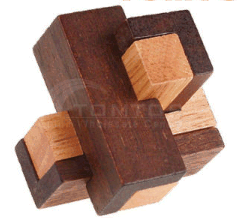
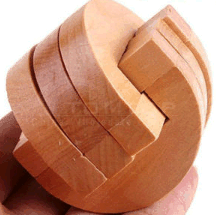
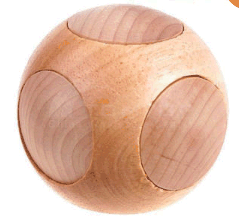
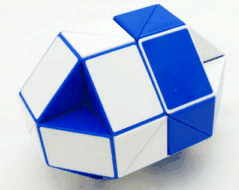
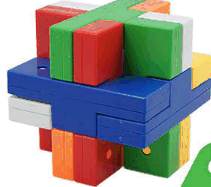
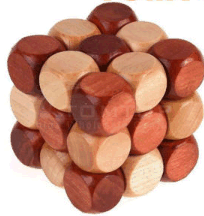
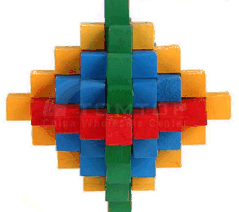
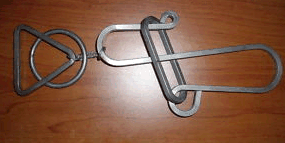
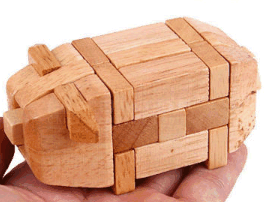
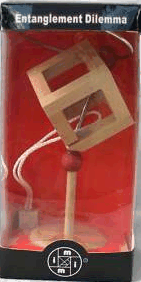
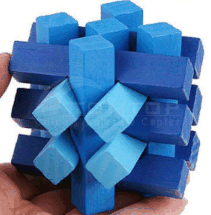

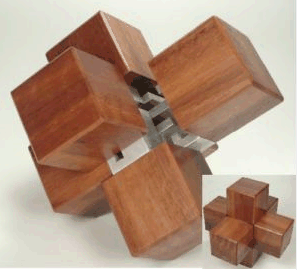 You’ve got just a few days left to
You’ve got just a few days left to 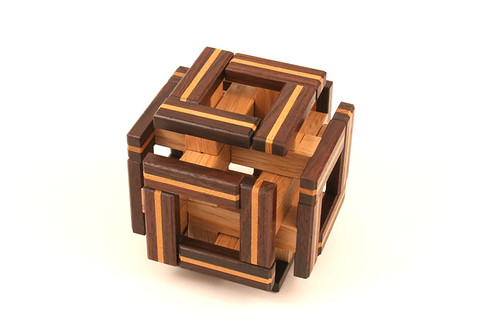
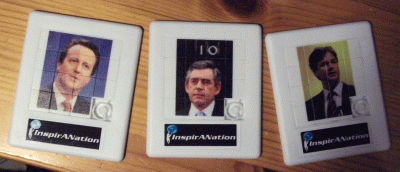
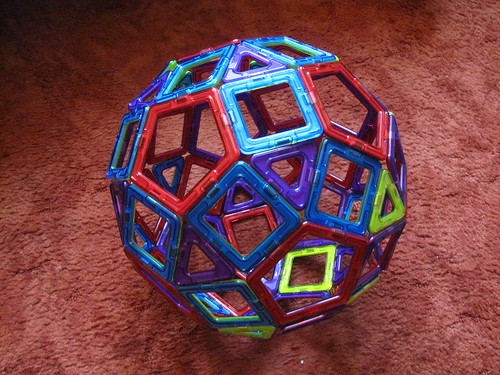
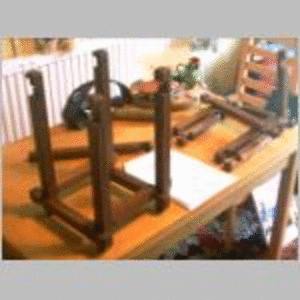
 I’ve designed a range of t-shirts in a load of vibrant colours with the slogan “My family went to MEXICO and all they got me was THIS LOUSY VIRUS”
I’ve designed a range of t-shirts in a load of vibrant colours with the slogan “My family went to MEXICO and all they got me was THIS LOUSY VIRUS”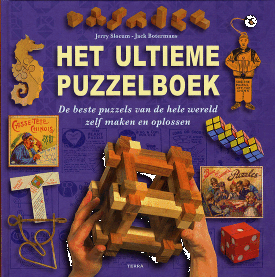 News from the puzzle books front, courtesy of my friend Ronald Kint-Bruynseels: A new book from Slocum & Botermans was published last month. Currently only in Dutch, “Het Ultieme Puzzelboek”, but an English (international) edition will be around early 2008. The publisher says that it contains some new and never before published material.
News from the puzzle books front, courtesy of my friend Ronald Kint-Bruynseels: A new book from Slocum & Botermans was published last month. Currently only in Dutch, “Het Ultieme Puzzelboek”, but an English (international) edition will be around early 2008. The publisher says that it contains some new and never before published material.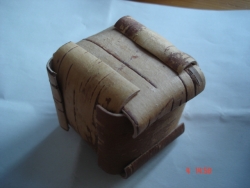
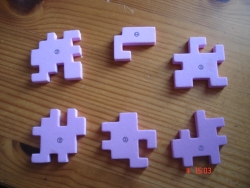 The picture here shows six puzzle pieces made from foam. Most readers here will be familiar with this type of puzzle. My friend Robert Reid found it somewhere, but we have failed to work out the object or solution of the puzzle. The six pieces would appear to be the faces of a cube, but we have failed to assemble it as such. Also the unit total of the six pieces appears misleading, as 125 does not seem to assemble easily to a cube. From left to right, and top to bottom the individual pieces total 26, 12, 23, 23, 21 and 20 units. Can anyone clarify this puzzle? It's possible that one or more pieces may be broken, but even close inspection makes it difficult to tell. I have other puzzles like this in my collection, either four units across or five units across, and as some pieces here are six units across, I am keen to know more about it. Finally, each piece has a number two in a circle
The picture here shows six puzzle pieces made from foam. Most readers here will be familiar with this type of puzzle. My friend Robert Reid found it somewhere, but we have failed to work out the object or solution of the puzzle. The six pieces would appear to be the faces of a cube, but we have failed to assemble it as such. Also the unit total of the six pieces appears misleading, as 125 does not seem to assemble easily to a cube. From left to right, and top to bottom the individual pieces total 26, 12, 23, 23, 21 and 20 units. Can anyone clarify this puzzle? It's possible that one or more pieces may be broken, but even close inspection makes it difficult to tell. I have other puzzles like this in my collection, either four units across or five units across, and as some pieces here are six units across, I am keen to know more about it. Finally, each piece has a number two in a circle 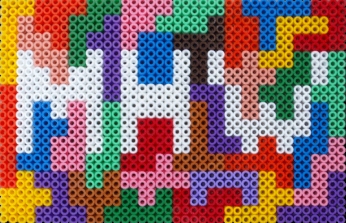 I was surprised and also delighted to receive a puzzle in the post from my friend Odette, who teaches at a
I was surprised and also delighted to receive a puzzle in the post from my friend Odette, who teaches at a 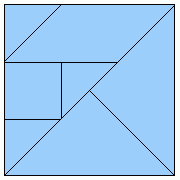 A couple of weeks ago I was at a puzzle party in Devon, and my old friend Laurie presented me with something similar to the diagram here. At first glance it looks like a standard tangram puzzle.
A couple of weeks ago I was at a puzzle party in Devon, and my old friend Laurie presented me with something similar to the diagram here. At first glance it looks like a standard tangram puzzle.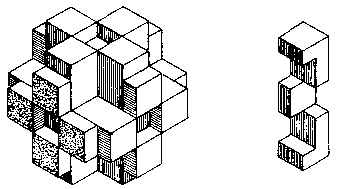
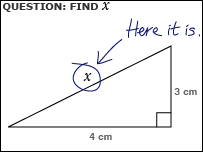 I can’t remember where I found this image but it makes me laugh!
I can’t remember where I found this image but it makes me laugh! 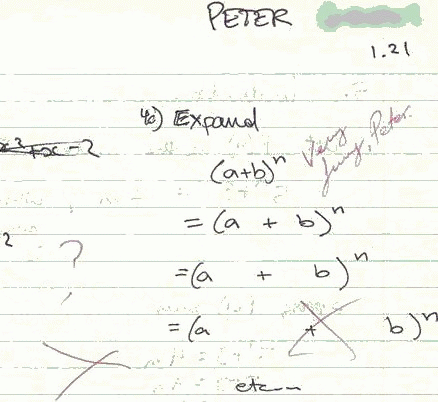
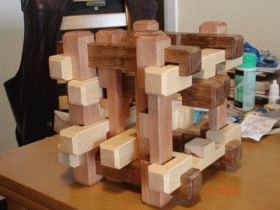
 The puzzle pictured here was designed by my friend and disentanglement puzzle expert Dick Hess. With puzzles of this sort it is normal to try and remove the shuttle. Dick has made it five times harder by providing you with five pieces to remove!. I'm embarrassed to say that I can only remove two! This is currently one of my favourite puzzles.
The puzzle pictured here was designed by my friend and disentanglement puzzle expert Dick Hess. With puzzles of this sort it is normal to try and remove the shuttle. Dick has made it five times harder by providing you with five pieces to remove!. I'm embarrassed to say that I can only remove two! This is currently one of my favourite puzzles.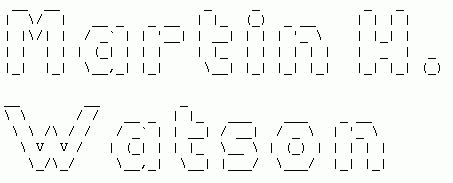
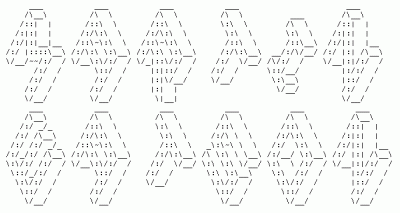
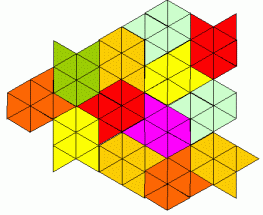
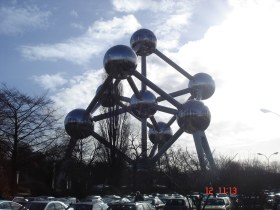
 Recently in the pub, I set myself the challenge of making a continuous loop of one colour, using any 19 tiles from the bag, to form an edge-three hexagon. It's not an extremely difficult challenge, but quite fun! Once you've achieved this, a greater challenge would be to shuffle just the same 19 tiles and then recreate the continuous loop once again! My next challenge is going to be creating a continuous loop of one colour, using 37 tiles, to form an edge four hexagon.
Recently in the pub, I set myself the challenge of making a continuous loop of one colour, using any 19 tiles from the bag, to form an edge-three hexagon. It's not an extremely difficult challenge, but quite fun! Once you've achieved this, a greater challenge would be to shuffle just the same 19 tiles and then recreate the continuous loop once again! My next challenge is going to be creating a continuous loop of one colour, using 37 tiles, to form an edge four hexagon.
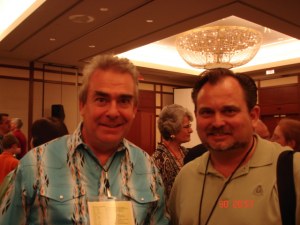 I think any one would find it a great struggle to argue against it being the most impressive website picturing a personal collection on the Internet. Robert and I have corresponded with each other for two or years, so I was delighted to finally meet him on a boat in Boston harbour in July 2006!. I was even more delighted when he told me that it was after seeing my site and John Rausch's
I think any one would find it a great struggle to argue against it being the most impressive website picturing a personal collection on the Internet. Robert and I have corresponded with each other for two or years, so I was delighted to finally meet him on a boat in Boston harbour in July 2006!. I was even more delighted when he told me that it was after seeing my site and John Rausch's 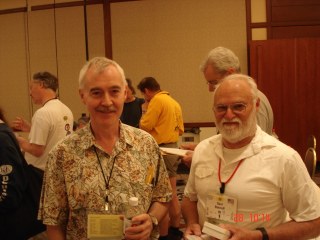 days in historic Philadelphia was a return to Boston for this year's International Puzzle Party. Held at the Hilton at Boston's Logan Airport, it was a wonderful five days of puzzles, puzzles and puzzles. It was excellently organised by Chris Morgan and his wonderful team of volunteers, our thanks to you all. Alice and I visited Boston three years ago before flying to Chicago for that year's Puzzle Party, so we were very familiar with the wonderful Massachusetts city. Located within walking distance of the airport terminals the hotel was a wonderful venue, although I think we all thought the staff could have been a bit more pleasant, and not constantly demanding tips.
days in historic Philadelphia was a return to Boston for this year's International Puzzle Party. Held at the Hilton at Boston's Logan Airport, it was a wonderful five days of puzzles, puzzles and puzzles. It was excellently organised by Chris Morgan and his wonderful team of volunteers, our thanks to you all. Alice and I visited Boston three years ago before flying to Chicago for that year's Puzzle Party, so we were very familiar with the wonderful Massachusetts city. Located within walking distance of the airport terminals the hotel was a wonderful venue, although I think we all thought the staff could have been a bit more pleasant, and not constantly demanding tips. 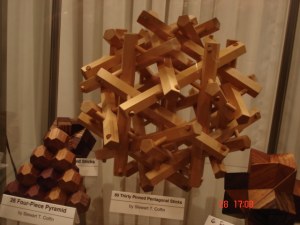 morning and afternoon saw the much-anticipated Puzzle Party, at which over a hundred puzzle collectors designers and sellers put their wares on offer. One of the highlights of the party was the opportunity to buy some of the master craftsman and designer Stewart Coffin's puzzles. His puzzles are so sought-after that the previous evening there had been a draw so that people would be able to purchase his puzzles in a seemly manner.
morning and afternoon saw the much-anticipated Puzzle Party, at which over a hundred puzzle collectors designers and sellers put their wares on offer. One of the highlights of the party was the opportunity to buy some of the master craftsman and designer Stewart Coffin's puzzles. His puzzles are so sought-after that the previous evening there had been a draw so that people would be able to purchase his puzzles in a seemly manner. 